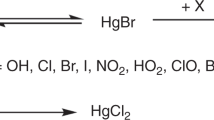Abstract
We have measured total gaseous mercury concentrations(Hg°) at Point Barrow, Alaska since September 1998 in aneffort to determine the geographic extent and reaction mechanismof the so-called mercury depletion events (MDE) previouslyreported in the high Arctic at Alert, Canada. Hg° has beensampled now for nearly 2 years at Barrow. In September, 1999, webegan making the first automated measurements of reactive gaseousmercury (RGM) attempted in the Arctic, along with measurements ofHg accumulation in snowpack to determine the fate of the ‘depleted’ Hg°. During the fall and early winter, Hg°and RGM exhibit only minor variation, Hg° remaining within∼10% of global background, near 1.6–1.8 ng m-3. The MDEperiods are quite different, however; within days of Arcticsunrise in January, Hg° exhibits major variations from themean, rapidly dropping as low as 0.05 ng m-3 and then cyclingback to typical levels, sometimes exceeding global background. These events continue throughout Arctic spring, then end abruptlyfollowing snowmelt, in early June. Prior to Arctic sunrise, RGMremains near detection (<2 pg m-3), but after sunriseincreases dramatically (to levels as high as 900 pg/m3) insynchrony with the ‘depletion’ of Hg°. Both phenomenaexhibit a strong diel cycle, in parallel with UV-B. We concludethat MDE's involve rapid in-air oxidation of Hg° to aspecies of RGM by photochemically-driven reactions, probablyinvolving the same reactive bromine and chlorine compoundsinvolved in ozone destruction. Sharp increases in Hg in thesurface snowpack after sunrise coincident with periods of peakRGM suggest surface accumulation of the RGM by dry deposition.
Similar content being viewed by others
References
Amyot, M., Mierle, G., Lean, D. R. S. and McQueen, D. J.: 1994, ‘Sunlight-induced formation of dissolved gaseous mercury in lake waters’, Environ. Sci. Technol. 28, 2366–2371.
Barrie, L. and Platt, U.: 1997, ‘Arctic tropospheric chemistry: An overview’, Tellus 49B, 450–454.
Berg, W. W., Sperry, P. D., Rahn, K. A. and Gladney, E. S.: 1983, ‘Atmospheric bromine in the Arctic’, J. Geophys. Res. 88, 6719–6736.
Bullock, O. R., Jr.: 2000, ‘Modeling assessment of transport and deposition patterns of anthropogenic mercury air emissions in the United States and Canada’, Sci. of Total Env. 259, 145–157.
Dietz, R., Riget, F. and Born, E.W.: 2000, ‘Geographical differences of zinc, cadmium, mercury and selenium in polar bears (Ursus maritimus) from Greenland’, Sci. of Total Env. 245, 25–48.
Dickerson, R. R., Rhoads, K. P., Carsey, T. P., Oltmans, S. J., Burrows, J. P. and Crutzen, P. J.: 1999, ‘Ozone in the remote marine boundary layer: A possible role for halogens’, J. Geophys. Res. 104, 385–21,395.
Fan, S.-M. and Jacob, D. J.: 1992, ‘Surface ozone depletion in Arctic spring sustained by bromine reactions on aerosols’, Nature 359, 522–524.
Hummelshøj, P., Courtney, M., Jensen, N., Sørensen, L., Skov, H. and Goodsite, M.: 2000, ‘Atmospheric Flux Measurements Using the Relaxed Eddy Accumulation (REA) Technique’, poster presented at the Danish Society for Atmospheric Research, November, 2000, Copenhagen, Denmark.
Landis, M. and Stevens, R. K.: 2000, ‘Recent Advances in Methods to Speciate Hg in the Atmosphere’, Proceedings of the EPA Conference on Analytical Chemistry, Sept. 2000, EPA Report (in prep).
Lindberg, S. E., Vette, A., Miles, C. and Schaedlich, F.: 2000, ‘Application of an automated mercury analyzer to field speciation measurements: Results for dissolved gaseous mercury in natural waters’, Biogeochem. 48(2), 237–259.
Lindberg, S. E. and Stratton, W. J.: 1998, ‘Atmospheric mercury speciation: Concentrations and behavior of reactive gaseous mercury in ambient air’, Environ. Sci. Technol. 32, 49–57.
Lindberg S. E., Meyers T. P. and Munthe, J.: 1996, ‘Evasion of mercury vapor from the surface of a recently limed acid forest lake in Sweden’, Water Air Soil Pollut. 85, 2265–2270.
Meyers, T. P., Hall, M. E. and Lindberg, S. E.: 1996, ‘Use of the modified Bowen ratio technique to measure fluxes of trace gases’, Atmos. Envir. 30, 3321–3329.
(NADP) National Atmospheric Deposition Program: 2000, ‘NADP Data Report 2000–01’, Illinois State Water Survey, Champaign, IL.
Oltmans, S. J., Schnell, R. C., Sheridan, P. J., Peterson, R. E., Li, S.-M., Winchester, J. W., Tans, P. P., Sturges, W. T., Kahl, J. D. and Barrie, L. A.: 1989, ‘Seasonal surface ozone and filterable bromine relationship in the high Arctic’, Atmos. Env. 23, 2431–2441.
Schroeder, W. H., Anlauf, K. G., Barrie, L. A., Lu, J. Y., Steffen, A., Schneeberger, D. R. and Berg, T.: 1998, ‘Arctic springtime depletion of mercury’, Nature 394, 331–332.
Scott, K. J., Rudd, J. W. M. and Kelly, C. A.: 1999, Short Term Changes in the Bioavailability of Inorganic Mercury in Lake Water Assayed by a Light-Emitting Bioreporter. Presented at the Air and Waste Management Association International Specialty Conference on Mercury in the Environment. Bloomington, Minnesota, September 15–17, 1999.
Stevens, R. K., Schaedlich, F. H., Landis, M., Schneeberger, D., Prestbo, E., Lindberg, S. and Keeler, G.: 1999, ‘Automated Instrument Designed to Measure Hg° and Reactive Gaseous Mercury in Near Real Time: Design and Operational Characteristics’, paper presented at the 5th International Conference on Mercury as a Global Pollutant, Rio de Janeiro, Brazil, May, 1999.
Wheatley, B. and Wheatley, M. A.: 1988, ‘MeHg in the Canadian Arctic Environment Past and Present—Natural or Industrial?’, Arctic Med. Res. 47, Suppl. 1, 163–167.
Xiao, Z., Sommar, J., Wei, S. and Lindqvist, O.: 1997, ‘A KCl denuder method for gaseous HgII’, J. Anal Chem. 358, 386–391.
Author information
Authors and Affiliations
Rights and permissions
About this article
Cite this article
Lindberg, S.E., Brooks, S., Lin, CJ. et al. Formation of Reactive Gaseous Mercury in the Arctic: Evidence of Oxidation of Hg° to Gas-Phase Hg-II Compounds after Arctic Sunrise. Water, Air, & Soil Pollution: Focus 1, 295–302 (2001). https://doi.org/10.1023/A:1013171509022
Issue Date:
DOI: https://doi.org/10.1023/A:1013171509022



